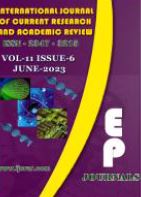Abstract Volume:11 Issue-6 Year-2023 Original Research Articles
 |
Online ISSN : 2347 - 3215 Issues : 12 per year Publisher : Excellent Publishers Email : editorijcret@gmail.com |
The essence to characterize biophysical features at a watershed level has a significant input for further Improvements to promote sustainable and productive livelihood through the integration of different watershed components in a participatory approach. The objective of this study was to assess the current biophysical characteristics of the Medo watershed in the West Arsi Zone of Oromia, Ethiopia. To do so, relevant data and tools were used; ArcGIS, Microsoft Excel sheet, and fundamental formulae were applied to the analysis. The results of the study indicated that the major land use types in the watershed are agricultural land covering 50%, vegetation (shrubs, forests, and, plantations) covering 24%, and settlement covering 16% of the total land use. The slope gradient of the Medo watershed ranges from zero to more than 20 and the slope gradient of 2-5 and 5-10 cover the greatest area coverage, representing 201 ha and 170 ha, respectively. We can also observe that about 8% of the total area is subjected to severe erosion. Sandy clay loam was the dominant soil textural classes in the surface soils, and Phaeozems, Retisols, and the dominant soil types, which covered 57%, 36%, 36, % and 7% of the sub-watershed area for lower, middle, and upper slope positions, respectively. The mean annual rainfall of the area ranges from 960.09 mm in the lower part of the watershed to 1304.93 mm in the upper part of the watershed. Accordingly, the Medo sub-watershed is laid in the majority of the sub-humid agro-ecological zone. An assessment of the trees within the watershed landscape showed some remnant natural forests and a wide variety of shrubby vegetation is encountered in all landscapes. About 40 % of the watershed is under high to extremely severe soil loss values (>45 tons per hectare per year). The baseline study also identified that natural resource degradation such as land and/or soil fertility, reduction, and recent changes in the area’s weather conditions in line with climate change prevailing in current years are few of the many factors that contribute to land and crop productivity reductions in the area. Therefore, prioritizing the identified problem and preparing intervention of different technologies and development plans by participating communities and different potential stakeholders to solve the problems by considering the existing opportunities of the watershed.
How to cite this article:
Kedir Jemal. 2023. Assessment of Medo Watershed on the Biophysical Aspect for Planning and Impact Monitoring, Central Rift Valley Area of Ethiopia.Int.J.Curr.Res.Aca.Rev. 11(6): 99-115doi: https://doi.org/10.20546/ijcrar.2023.1106.009



Quick Navigation
- Print Article
- Full Text PDF
- How to Cite this Article
- on Google
- on Google Scholor
- Citation Alert By Google Scholar
